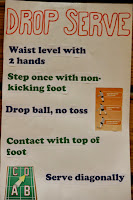What?
For my lab D, my team and I taught a lesson on the game of
Nohejbal from the Czech Republic.
This is a game that requires some prior knowledge in the sports of
tennis, volleyball and soccer. The
game is played on a badminton-sized court with a low net. I did my teaching segment on the skills
of serving the ball and controlling the ball to set up for the return. To assist the students in learning I
created two visual aids that outlined the guidelines of the serve and
control. Also to make the activity
less difficult and safer for the students we decided to use a larger ball to
focus on control and form. Some
students picked up the skill right away and others it took a couple of practice
serves. Controlling the ball came
easy to the class because the larger balls traveled much slower and provided
students with an ample amount of time to adjust to the trajectory of the
ball. I modified the activity
after everyone got a chance to serve 5 times to add the in the return. This allowed students to work on team
work to set up an affective return while also providing a good lead up to the
next activity where they would work on the strike.
 |
| My visual aids for the serve and the control! |
Gut?
Nohejbal interested me right from the first video I saw of
it. I liked how it took three very
common games to me and combined them into one. I was unsure of how well I would work with a group, but we
worked very well together and all had great ideas on how to teaching the
lesson. I felt that the students
picked up the game quickly because of how well our lesson flowed. We started off with the basics and then
implemented essential techniques to lead up to game play. By the end of the lesson, the students
understood the skills and rules enough to play a full game of 3 on 3. When I was demonstrating the skill of the
serve, I would have changed the order in which I demonstrated it. I should have demoed the skill first
and then bring it into the visual aid. This way the students can have an idea
of what the skill looks like before I give them the guidelines for it. Comparing this lesson to my lab C, I
like being able to teach the class a skill/game that they have never performed
before because it allowed me to see skill improvement and knowledge learned
within the students.
So What?
The students learned through practicing the tasks presented
to them. To keep them interested
we constantly switched the task when we felt the students were ready to move
on. Each activity was a good lead
up to the next one that would build on the previous task. Our goal was to get the students to
understand the skills and basics well enough to participate in a full game. I learned that to make a lesson
successful it needs to have a good flow that will challenge the students and
build on the previous skill while keeping the class engaged. It is also important to know when to
move on to the next task. All
students should have a good understanding of the skill before moving on because
if students get left behind they could easily lose interest and not want to
participate anymore.
 |
| Giving corrective feedback to Hannah! |
Now What?
The students did a great job communicating and working as a
team when they began game play. In
the next lesson they will learn techniques for positioning and placing the ball
while continuing to use communication to set up for an effect strike. From this lesson I was able to observe
how quickly the class learned a brand new sport. They were very successful in staying on task and completing
what was expected of them. I am
now much more confident in my teaching then I was when I started my first lab. I think that I improved most in the
aspect of giving good feedback. In
my earlier lessons I would give positive feedback but not corrective feedback
that would support student learning.
In my lab D, I felt that the comments that I gave the students helped
them to master the skill. I also
liked being able to work with a group because we were all able to share our
ideas and leave all the best ones on the table. The group also worked well because we were able to look over
each other’s work and make any needed tweaks to perfect our lesson.



No comments:
Post a Comment
Note: Only a member of this blog may post a comment.